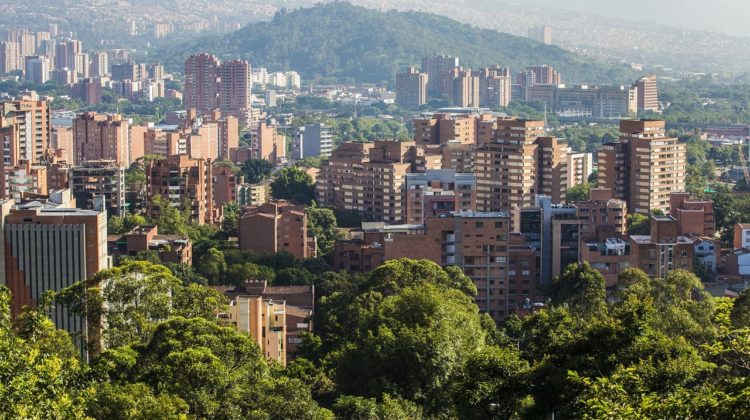
The Story of How Medellin Turned Its Water Reservoirs into Public Parks
While developing a master plan for Medellin s urban lighting system, EPM, Medellin s public utility company, analyzed the Colombian city s infrastructure and nocturnal lighting system by superimposing a map of the system over a map of the city. What they found was an urban landscape blotted by islands of darkness.
Much to the surprise of the utilities company, the dark spots were actually water tanks that were initially built on the city s outskirts; however, thanks to the progressive expansion of Medellin s city limits, the tanks now found themselves completely surrounded by the informal settlements of the Aburra Valley. Even worse, they had become focal points for violence and insecurity in neighborhoods devoid of public spaces and basic infrastructure.
Through their Sustainable Urban Interventions Department DIUS, EPM analyzed the water tanks based on aspects like usable land, population density, the neighboring community s needs, geological restrictions, the expansion of the aqueduct, and the surrounding area. They later chose tanks and, from there, narrowed their list down to the tanks most in need of intervention, giving birth the to ambitious project of creating quality public spaces in Medellin s poorest neighborhoods, dubbed the UVA or Articulated Life Units.
In a project that was featured in the Venice Biennale of Architecture, EPM applied participatory design strategies that would emphasize their role, not only as a utility company, but citizens of Medellin. In a beautiful ad hoc metaphor for the times, the walls around the water tanks were torn down to allow access to the community surrounding them. Now, each tanks forms a part of a network that validates Medellin s interest in re-purposing the places that were once centers for violence and conflict.
Official Description: Each water tank was seen as a tool in forging a new relationship of trust with the communities surrounding them: working hand in hand with the residents in designing the project, the common goal was to transform something that was once closed and secret into something open and interactive. The resulting project was a mix of the existing water infrastructure–a valuable community resource– with a public space.
The water tanks were opened, the walls around them dismantled, and the surrounding area was redesigned to create a totally re-imagined public space, creating new connections with the community that was once kept out. The project ultimately created a space for equality to replace the division and exclusion that once marked the area. As a response to the lack of public spaces in these neighborhoods, the walls around the water tanks were torn down and became centers for recreation and culture. In an act of generosity and trust, hydraulic infrastructure became public infrastructure that served to revamp the surrounding communities.
By creating public spaces, transformations can happen on multiple scales. This project in particular aims to give new life and use to already existing infrastructures and to open them to the community. In the neighborhoods, each one of the buildings seeks to establish new urban connections, enriching the local dynamic and creating new focal points within the city.
For EPM, the goal of transforming the water tanks was to provide a place for people to congregate and hold events. To accomplish this, the project s design aimed to create as much public space as possible for residents to utilize and enjoy.
To accomplish this, EPM established design strategies to identify the particular aspects of each tank and how they fit into their surroundings. Whether the tanks were in closed surfaces, exposed surfaces, or partially underground, EPM took into account both the conditions of the tanks and the land surrounding them when laying out the remodeling plan. In essence, the topography and the landscape generated the form of the public spaces and the architecture while the structure became a building and the public space surrounding it, an urban balcony.
Another facet of the remodel of the reservoirs was creating trails and other mobility systems that spanned the land surrounding the tanks, connecting once-isolated neighborhoods and allowing residents access to other parts of the city. Additionally, the tank and its infrastructure became the building. In other words, the water tank is the centerpiece of the project, bringing together all the other changes as a way to highlight its unique position in the urban landscape.
Finally, water and light are the fundamental elements behind the project and served as the starting point for the master lighting plan laid out by the city. These elements are fundamental in making a public space usable and highlight the already essential function of the water tanks, which will continue serving the community as both an aqueduct and a gathering place.
Original Infrastructure: Moscú TankNeighborhoodCommune: San Pablo, PopularAddress: Calle #-Design and Construction: January – March
Original Infrastructure: Orfelinato TankNeighborhoodCommune: San Miguel, Villa HermosaAddress: Carrera #-Design and Construction: March – November
Original Infrastructure: Campo Valdés TankNeighborhoodCommune: Santa Inés, ManriqueAddress: Carrera #-Design and Construction: March – February
Original Infrastructure: La Tablaza TankNeighborhoodCommune: Santa Inés, ManriqueAddress: Carrera #-Design and Construction: July – November
Original Infrastructure: Versalles TankNeighborhoodCommune: La Libertad, Villa HermosaAddress: Calle #B-Design and Construction: May – February
Original Infrastructure: Santa Elena TankNeighborhoodCommune: La Libertad, Villa HermosaAddress: Calle #B-Design and Construction: May – February
Original Infrastructure: Santo Domingo TankNeighborhoodCommune: La Avanzada, PopularAddress: Calle B #A-Design and Construction: July – October
Original Infrastructure: San Fernando Water Treatment PlantNeighborhoodCommune: San Fernando, Comuna , ItagüíCompleted:
Other UVAs built include Los Guayacanes, Mirador San Cristóbal, La Cordialidad, El Encanto, and Aguas Claras
